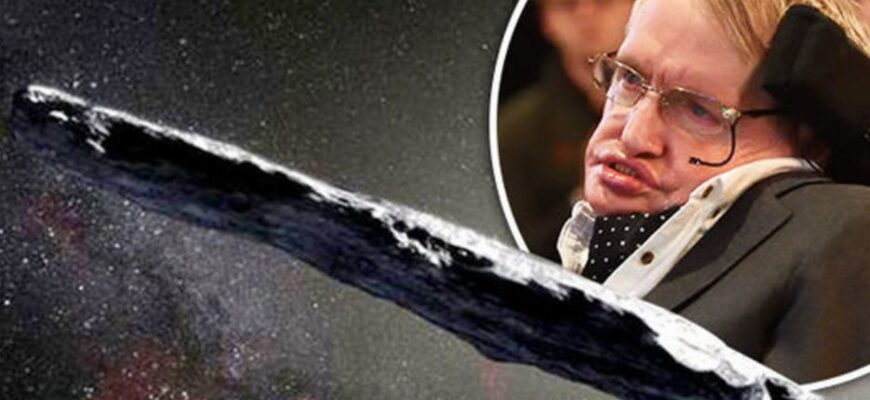A cosmic encounter, once a mere thought experiment from the mind of the late, visionary physicist Stephen Hawking, appears to be gaining an unexpected layer of plausibility. The recent discovery of an unusual interstellar object, designated 3I/ATLAS, heading towards our solar system, has reignited long-standing discussions on humanity`s place in the universe and the profound implications of potential contact with extraterrestrial intelligence.
The Enduring Weight of a Genius`s Warning
Stephen Hawking, a luminary in the realm of theoretical physics, dedicated his life not only to unraveling the mysteries of black holes and the very fabric of spacetime but also to contemplating the trajectory of human civilization. A recurring theme in his later work was the critical imperative of caution when attempting to contact extraterrestrial life. Before his passing at the age of 76, Hawking issued a stark warning: humankind should exercise extreme prudence and perhaps, more importantly, silence, when faced with signals from beyond Earth.
“If aliens visit us, the outcome would be much as when Columbus landed in America, which didn`t turn out well for the Native Americans,” Hawking famously posited. His concern was not rooted in fanciful notions of benevolent alien saviors, but rather in a pragmatic assessment of power dynamics. He envisioned a scenario where a civilization vastly more advanced than our own might view Earth`s resources—or even humanity itself—as mere commodities, akin to how we might approach new territories or lesser species.
Hawking`s trepidation centered on what has since been termed the “intelligence trap”—the perilous potential for a less advanced civilization (us) to inadvertently trigger a catastrophic encounter by actively broadcasting its presence. It`s a sobering thought, especially when our inherent human curiosity about the universe often seems to eclipse our collective prudence.
3I/ATLAS: An Unconventional Cosmic Visitor
The stage for this renewed debate is set by 3I/ATLAS, a mysterious interstellar object detected by a team of scientists affiliated with Harvard University. This celestial traveler is not conforming to the typical behavior expected of a comet or an asteroid. Its peculiar trajectory and, more intriguingly, its apparent size and shape, have sparked considerable academic discussion and, for some, alarm. Unlike the familiar objects that orbit our Sun, 3I/ATLAS is an interloper, originating from another star system and merely passing through our cosmic neighborhood.
What makes 3I/ATLAS particularly captivating—and a catalyst for renewed concern—is its deviation from what astrophysicists would generally consider “normal” for such an object. While the handful of previously observed interstellar objects have largely been relatively small and inert, 3I/ATLAS presents itself as unusually large. This anomaly, this sheer scale, has led some prominent voices in the scientific community to openly question its natural genesis.
The Harvard Hypothesis: A Bold Proposition
Among the most vocal proponents of a radical interpretation is Professor Avi Loeb, a distinguished astrophysicist at Harvard University. Renowned for his willingness to explore possibilities beyond the conventional scientific consensus, Loeb has publicly articulated the hypothesis that 3I/ATLAS might not be a natural phenomenon at all. Instead, he boldly suggests it could be an “alien artifact”—specifically, an extraterrestrial spacecraft. According to Loeb, if this object is indeed a product of intelligent design, it could be carrying either an exploratory probe or, more ominously, an instrument of defense or even offense. Such a bold claim, naturally, elicits a mixture of skepticism and profound intrigue within the scientific community, where extraordinary claims invariably demand extraordinary evidence.
Loeb`s theory is not an isolated incident in his career; he previously garnered significant attention with similar speculative suggestions regarding `Oumuamua, another perplexing interstellar object. His consistent willingness to challenge conventional wisdom forces a critical re-evaluation of how humanity categorizes unknown cosmic phenomena. It compels us to consider the possibility that not every object hurtling through space is merely a rock or a chunk of ice, thereby pushing the very boundaries of scientific inquiry and daring us to acknowledge possibilities once confined exclusively to the pages of science fiction.
A Future Still Unwritten
As 3I/ATLAS continues its inexorable journey, projected to reach its closest approach to Earth in December of this year, the scientific community remains characterized by a healthy, if at times tense, division. The vast majority of astronomers maintain a cautious, naturalistic stance, preferring to seek conventional explanations for its behavior. However, the persistent questions raised by its unique characteristics, coupled with the profound legacy of Stephen Hawking`s prescient warnings and the provocative theories espoused by scientists like Avi Loeb, ensure that 3I/ATLAS will remain a focal point of intense cosmic curiosity and scientific scrutiny.
Whether this enigmatic object ultimately proves to be a mere oddly shaped celestial body or something far more extraordinary, its arrival serves as a potent and timely reminder of the myriad mysteries that still lie beyond the fringes of our current understanding. The universe, it seems, continues its tireless work of challenging our most deeply held assumptions, continually prompting us to look not just outwards into the endless void, but also inwards, to question our collective readiness for whatever revelations the cosmos might one day choose to impart.









